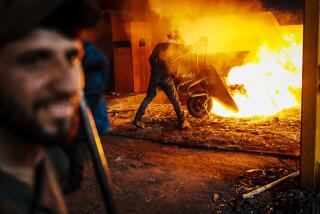Afghans Selling All They Can Sell
- Share via
MAZAR-I-SHARIF, Afghanistan — The best bargain in the bazaar here is not the gold-spotted lapis lazuli beads, the wolf skin cap or the Ahmed Shah Masoud commemorative rug.
It’s the GI sleeping bag.
Or the Gore-Tex cammies.
Or the size 12 combat boots, limousines for most Afghan feet and sold at a “special price” because so few people here can wear them.
In early October, as America ramped up to wage war against the terrorist-supporting Taliban regime, Air Force jets zoomed over remote Afghan villages, dropping guns, ammunition, combat fatigues--”cammies” in Army-speak--and other supplies to Northern Alliance soldiers.
Since then, Mazar-i-Sharif’s markets have been looking a bit like Army surplus stores.
Many Northern Alliance soldiers, who typically go weeks without a paycheck, have chosen to sell their new gear instead of use it. Poor villagers have tromped into the city lugging sacks of recovered materiel to cash in on the gifts from the sky.
The items cost a fraction of what they do in the United States--or what it took to fly them halfway around the world.
Take the U.S. Special Forces sleeping bag, a high-quality worm-shaped black polyester tube that retails in America for $160. Here, the going price is about 13 bucks.
Black leather combat boots run about $6.90, unless they’re over size 10. Then they’re half off.
Need an Army-green waterproof backpack? Many foreign journalists did, picking them up for the equivalent of $3, compared with $35 back home.
The deals are so good that the stuff is getting snapped up by real soldiers--Jordanian troops, French paratroopers, even U.S. officers.
“Heck, if I lose my sleeping bag, I’ll have a backup,” said Army Maj. Martin Rose, who’s stationed in Mazar-i-Sharif.
U.S. commanders insist that most airdrops reached their targets.
“There’s no way to quantify it, but we’re confident the majority of shipments got to our guys,” said the U.S. Central Command’s Col. Rick Thomas.
Some shipments were intended for small contingents of Special Forces soldiers who were traveling light in the war’s early days and needed to be resupplied by air. The deliveries stopped in mid-December, when the Taliban fell.
U.S. military officials say they’re unable to measure how many military-related supplies were unloaded, though figures are available for humanitarian aid: 3.4 million pounds of wheat, 2.5 million daily rations and 328,000 blankets.
A lot of that went to the market too, with blankets and daily rations big sellers this fall.
Most Northern Alliance soldiers in Mazar-i-Sharif still stroll around in faded camouflage and old Soviet belt buckles with the hammer and sickle scratched off.
It’s the higher-ranking commanders who are outfitted in smart American-made fatigues.
“Now I’m just like Green Beret,” said ethnic Uzbek Gen. Abdul Hak Sakra, tugging the lapels of his crisp new Gore-Tex field jacket.
Ata Mohammed, an ethnic Tajik commander and former protege of Masoud, the anti-Taliban leader assassinated in September, even secured a set of fatigues for his 7-year-old son, Khalid.
“A gift for my little commander,” he said, rubbing the boy’s head during a recent interview.
These days, the best place to find new gear is at the southwestern corner of the blue mosque, a stunning, intricately decorated bright blue dome in the center of town.
On Saturday, sleeping bag seller Mohammed Dullah paced the sidewalk, shouting “Bista sefari! Bista sefari!” which literally means “traveling bed.”
A woman beneath a diaphanous white burka approached him, inspected the quilted bag, asked the price and then hurried away.
Even at below cost, the surplus gear is still too expensive for most Afghans, and vendors are often left waiting for aid workers, journalists or foreign soldiers to buy their wares.
“It’s like hunting,” Dullah said. “Some days you get so many. Other days you get none.”
More to Read
Sign up for Essential California
The most important California stories and recommendations in your inbox every morning.
You may occasionally receive promotional content from the Los Angeles Times.













